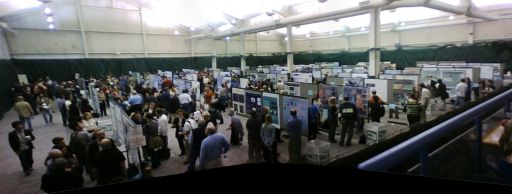Emily Lakdawalla • Mar 12, 2008
LPSC, Tuesday: lunar talks, poster session, and Io
The writeups below came from Ted Stryk, whom I met in person for the first time at the Lunar and Planetary Science Conference on Monday. Ted is a professor of English by occupation but those of you who are regular readers of this blog should be familiar with the incredible work he does to make beautiful images out of the oldest and most intractable data sets from missions that performed our first reconnaissance of the solar system; see here for one example.
Before I give Ted the floor, I also want to point to Cassini team member and Io expert Jason Perry's new blog, the Gish Bar Times, where he has been posting detailed writeups on all the Io presentations at this week's conference, as well as new versions of many of the Galileo images of Io. And, finally, Jason asked me to point out the detailed "Looking Ahead" feature on the Cassini ISS team website about today's Enceladus flyby. --ESL
CK Shearer gave an interesting talk concerning the idea that the lunar surface might have been molten for sixty million years after its formation. Previous models indicated twenty to fifty million years. While this was interesting, the exact effect on the current lunar surface was less than clear.
Paul Lucey and Jeffrey Taylor gave a presentation on the scientific importance of the lunar poles. They made clear that while most talk concerning exploring these regions circles around the use of possible water [in permanently shadowed areas] there as a resource, the poles are interesting in their own right. They pointed out that the rim of [south polar crater] Shackleton is illuminated by sunlight, and so if one considers reflected light, no region on the Moon may be dark enough to have preserved volatiles forever. Thus, they proposed that volatiles at the poles may actually be the result of comet impacts, and that there may be some kind of equilibrium at play in which the poles are resupplied by comets, balancing out what is lost to space over time.
There were some excellent posters on display last evening.
Phil Stooke presented his Eros map. It is amazing to see that a world of that size has significant albedo variations. The bright areas are the disturbed areas, but they are just as likely to exist on steep slopes in older craters as they are on fresh ones.
Kandis Lea Jessup had an interesting Io poster. Based on Hubble studies of the Tvashtar eruption going on during the New Horizons encounter, it appears that while the volcanic plumes have long been considered to be a combination of SO2 and S2, given the strength of the SO2 spectral signature, the SO2 overwhelms the S2 by a ratio of between 50 to 1 and 100 to 1.
Dave Senske from JPL had a poster on the Jovian Science Orbiter. The main camera is going to be a HiRISE-like instrument, while the medium-resolution camera is nothing to sneeze at -- it will be able to achieve sub-meter resolution from Ganymede orbit. He pointed out that this mission would be able to take detailed measurements of Europa to accurately characterize how it reacts to tidal strain, further constraining the nature of its ocean, and helping with the design of any future Europa mission. He also pointed out the importance of studying Ganymede, only one of three solid worlds known to have an active dynamo generating a magnetic field (the others are of course Mercury and Earth).


 Explore Worlds
Explore Worlds Find Life
Find Life Defend Earth
Defend Earth


